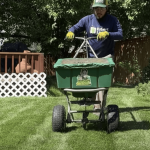The first step to achieving that vibrant, lush, green space you’ve always dreamed of is to properly aerate your lawn. At Erbert Lawns, we believe in the transformative power of good lawn care, and lawn aeration is a cornerstone of that belief. In this guide, we’ll take you through the process, so you can have the most healthy and beautiful lawn possible.
- Why Aerate Your Lawn?
- When and How to Aerate?
- Steps to Aerate Your Lawn
- The Importance of Regular Aeration
- Choosing the Right Aeration Tools
- Soil Testing Prior to Aeration
- After Aeration: Seeding and Fertilizing
- Care for Your Lawn Post-Aeration
- Hiring Professionals for Aeration
- Conclusion
- Frequently Asked Questions
Why Aerate Your Lawn?
A well-aerated lawn ensures your grass can breathe easy. According to a study by the USDA, lawn aeration can improve the health of your grass by 25%. Aeration also helps your lawn absorb water more efficiently, reducing water runoff and, as a result, your water bill.
Improves Water Uptake: Aerating your lawn can lead to a significant improvement in water absorption, reducing wastage and saving money on your water bill.
Increases Nutrient Absorption: It’s not enough to just water your lawn; your grass also needs to absorb essential nutrients. Aeration helps facilitate this process.
Boosts Air Exchange: Just like humans, grass needs air to breathe and grow. Aeration helps improve air exchange between the soil and atmosphere.
When and How to Aerate?
The best time for aeration is during the growing season, when the grass can heal and fill in any open areas after soil plugs are removed. The U.S. Department of Agriculture recommends aerating your lawn during late spring or early fall for cool-season grasses and late spring for warm-season grasses.
Steps to Aerate Your Lawn
Follow these steps to effectively aerate your lawn:
- Water Your Lawn: Water your lawn thoroughly one to two days before aerating it. This helps the aerator penetrate the soil and pull out soil cores much more easily.
- Prepare the Aerator: Rent or purchase a lawn aerator. A manual aerator is suitable for smaller lawns, while power aerators are ideal for larger lawns.
- Aerate Your Lawn: Run the aerator over your lawn, just like you would with a lawn mower. Make sure to cover every part of your lawn.
- Leave the Soil Plugs: Don’t pick up the soil plugs; let them decompose on the lawn. They add valuable nutrients back into the soil.
- Water Again: Once you’re done aerating, water your lawn well.
The Importance of Regular Aeration
Understanding the importance of aeration in maintaining a lush, green lawn is just the beginning. Regular aeration, at least once a year, is necessary to consistently maintain healthy grass. Soil, especially in high traffic areas, tends to become compacted over time. This compaction makes it harder for grass roots to grow, leading to thin or bare patches. Regular aeration can help alleviate this compaction and promote healthier, more vigorous growth.
Choosing the Right Aeration Tools
There are different types of aerators you can use, and your choice will depend on the size of your lawn and the soil type.
Spike Aerators use a wedge-shaped spike to create holes in the soil. They’re simple and affordable, but they may further compact the soil surrounding the holes. These are best for looser soil types.
Plug or Core Aerators remove a plug of grass and soil, which alleviates soil compaction better than spike aeration. They’re preferred for clay or silt soils, which are more prone to compaction.
There are manual and power versions of both types. For larger lawns, you might consider renting a power aerator. Our article on lawn care can help you make the best lawn.
Soil Testing Prior to Aeration
A soil test can reveal a lot about your lawn’s health and is a good practice before you aerate. This will tell you about your soil’s nutrient content and pH level, information that can guide your aeration process and subsequent lawn care.
After Aeration: Seeding and Fertilizing
Aeration is an excellent time to overseed your lawn, as the seeds will have direct access to the soil through the holes created by the aerator.
Similarly, fertilizing your lawn after aeration can help provide the nutrients your grass needs to grow thick and healthy. Using a slow-release fertilizer can provide steady nutrients over several weeks.
Care for Your Lawn Post-Aeration
After aeration, your lawn will need a bit more care than usual. According to the U.S. Environmental Protection Agency, regular watering is key to ensuring a healthy lawn post-aeration. The holes from aeration will cause your lawn to dry out more quickly, so it’s important to water it consistently.
Don’t worry about the soil plugs left on your lawn; they will decompose and return vital nutrients back to the soil, contributing to the overall health and vitality of your lawn.
To protect your newly aerated lawn, you should also avoid heavy traffic for about a week following aeration, to prevent the soil from becoming compacted again. This advice, as recommended by the U.S. Department of Agriculture, ensures that your lawn has ample time to recover and benefit fully from the aeration process.
Hiring Professionals for Aeration
While DIY lawn aeration can be a fun and rewarding experience, there are many benefits to hiring professionals. A professional lawn care service, like Erbert Lawns, has access to professional-grade equipment and the expertise to ensure your lawn receives the best possible care.
Remember, an aerated lawn is a happy lawn. By giving your lawn the care and attention it needs, you can transform it into a vibrant, green oasis you can be proud of.
Conclusion
Lawn aeration can seem intimidating, but with this guide and a bit of determination, you can transform your outdoor space into a lush, green oasis. Remember, the key to a healthy lawn is regular care, and aeration is a big part of that.
If you have any questions or would like professional assistance, don’t hesitate to contact us at Erbert Lawns.
Frequently Asked Questions
1. Can I Aerate My Lawn Too Much?
Yes, over-aeration can damage your grass. It’s recommended to aerate your lawn once or twice a year, depending on its condition and the type of soil.
2. When is the Best Time to Aerate Your Lawn?
The best time to aerate your lawn is during the growing season, typically in the spring or early fall.
3. What is the Benefit of Aerating Your Lawn?
Aerating your lawn helps the roots grow deeply, improves water and nutrient absorption, and boosts air exchange between the soil and atmosphere.
4. Should I Water My Lawn After Aerating?
Yes, it’s crucial to water your lawn after aeration to help the grass recover and to aid the decomposition of the soil plugs.










